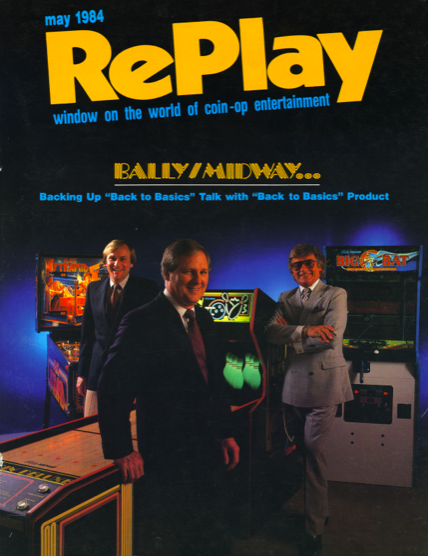Stan Jarocki, whose industry resumé includes key positions at Seeburg, Midway Mfg. and American Laser Games, passed away peacefully in his Albuquerque, N.M., home May 14 at the age of 94. He is survived by his wife of 72 years, Diane, as well as five children, nine grandchildren and nine great-grandchildren.

While Tori Iwatani was the creator of Pac-Man and the late Namco Chairman Mr. Masaya Nakamura the father of Pac-Man, Jarocki himself has been called “Mr. Pac-Man.” As an example, independent games researcher Ethan Johnson, wrote on X of Jarocki: “Mr. Pac-Man himself. There was no bigger champion for the legendary game in the U.S. than Jarocki, who moved mountains to make it the success it was. His salesmanship put him at the pinnacle of legendary product movers of the era of arcade video games.”
His son Jim said, “There are so many things to say about a guy who was a hero to me, a great mentor and friend, but I also think his friends in the business – and even those who never met him – would like to know a few of the things he did. He really loved the business and the people in it.”
Born July 13, 1929, in Chicago, he graduated from Tuley High School. His father, Stanley Sr. was a tool maker at the Seeburg Corporation and found him his first job in coin-op sweeping the loading docks.
Called into military service in 1951, he served with distinction in the Korean War as a Combat Infantryman, attaining the rank of Staff Sergeant.
Coming back home in 1953, he returned to Seeburg to continue his five-decade career in coin-op. At that time, Seeburg was the steam in the jukebox business, being the first (1951) to introduce a commercial jukebox to play the new 45s. Company execs, recognizing Stan’s abilities, moved him into a sales promotion position while he continued his education in marketing at Northwestern University.
Jim said, “He pioneered many initiatives in commercial and home entertainment, including national promotions for Seeburg’s Discotheque program in 1965. He was also instrumental in the mini-LP project, Seeburg’s background music equipment and home entertainment products. Stan continued to rise in the company to Vice President of Sales and Marketing, creating life-long relationships with distributors and operators worldwide.”
Shifting to the new video game industry in the late 1970s with Electra Games of Elk Grove Village, Ill., Stan helped create one of his favorite games, Flying Fortress. He then joined Midway Manufacturing Co., known at that time for bringing Taito’s Space Invaders and Namco’s Galaxian to the U.S. at a time when such key Japanese game companies didn’t have their own offices and factories in the states.
Responsible for developing and licensing new concepts, Stan discovered a game from Namco known in Japan as Pakuman. Stan recognized that Pakuman was truly different. He observed, “Here we had a maze game, non-violent and easy for anyone to play, yet challenging to the best players. I knew that this concept could bring females, older people and non-arcade patrons into the world of coin-op — a true expansion of our player base.”

Pakuman (or “Puck-Man” as it was briefly called) was modified for the U.S. market, becoming Pac-Man. Later, of course, came Ms. Pac-Man. Wrote Jim, “These were the most successful arcade games of all time with its 1983 factory production rate of over 1,200 units daily and over a quarter million cabinets produced.
“Stan appeared on the popular Phil Donahue show and during the heyday of Pac-Man, was interviewed by worldwide media, including Time magazine,” Jim continued. “In addition, he was responsible for licensing the Pac-Man characters for hundreds of consumer items from lunchboxes to bicycles, a Hannah-Barbera animated series and even the Gold-Record song, Pac-Man Fever. Truly, it was the first time the coin-op industry crossed over to the consumer world.”
Two of his children caught the amusement game business bug as well. Daughter Susan Jarocki Barone, for whom Stan named the “Sue” ghost in Ms. Pac-Man, followed him into the business, most notably at SNK; Jim worked with him at Bally/Midway (and also later at American Laser Games).
“We had a downturn and layoff at Midway in 1984,” said Jim, “Dad called me in to be the first let go. He wanted to show there was no favoritism during those hard times and I think that epitomized the integrity he had.”
Stan began his retirement in 1991, settling in Albuquerque, but pretty quickly reentered when he was asked to join American Laser Games as its Vice President of Sales and Marketing. The company brought big-screen, live-action video games such as Mad Dog McCree and Drug Wars to locations worldwide. His creativity led to another ALG hit, Fast Draw Showdown.
After his second retirement, he tried bull riding, learned silversmithing and created custom jewelry, Jim said. Stan was active as President of the local Korean War Veterans Association and was a featured speaker at the Korea-America Remembrance Group, hosting many dignitaries and being proclaimed an Ambassador of Peace by the Minister of Patriots and Veterans Affairs of the Republic of Korea.
He continued to be sought for interviews about the industry leading to the book Pac-Man: Birth of an Icon and most recently told his story in April for an upcoming network series on his experiences in the coin-op industry.



